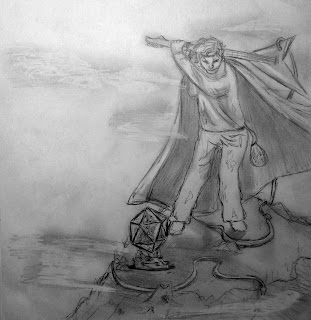"Magnolia Scepters" by Starr Weems. 15x22
The layers in a poured painting are both unified and complex, like the flavors in a fine wine. This effect is due to transparent glazes.
Ok, so you want to start pouring. What kind of paint do you need? That’s what everyone asks me.
Well, you want to have at least three tubes: the primary colors. Which primaries you should choose is a whole ‘nother post, because there are really more than just the three that you were taught about as a kid. (I know, I know. First the brontosaurus and now this. Your childhood was a lie.)
Let’s assume you have the color thing under control. What kind of paint do you need? There are lots of factors to consider and I will get to those. What I’d like to focus on today is transparency.
In general, I'm not a watercolor snob. I don't sniff condescendingly when I see a tube of china white in another artist's paint box or (gasp!) ivory black. Someone uses gouache to "cheat" on highlights. So what? If the final product is nice, then who cares? But... When it comes to pouring layers, paint type is very, very important. It’s gotta be transparent.
Why is transparency so crucial for pouring? Because your colors are mixing right there on the paper, not on a palette. Think of it like this:
You are stacking sheets of colored glass on white paper. You lay down a sheet of yellow and then a sheet of blue on top of that. The light travels through the layers of transparent glass, bounces off of the white paper and delivers a vibrant green color to your eye.
What if you replace the transparent blue sheet of glass with translucent, milky glass? Or what if one of the glass sheets is dirty? How does that change what you see? You still might get green, but there is no brilliant clarity.
If you pour 6 layers of paint, but one of those paints is even just semi-transparent instead of totally transparent, then with each pour, the light is hindered just a little as it travels through the layers. You don’t want that! You want deep, clear, shining color, not a murky puddle.
So how do you know if the paint is transparent? Most manufacturers have a chart. Sometimes it is marked right on the tube, which is nice.
If you have a tube of paint that you are not sure about, you can test the transparency yourself by drawing a line with a Sharpie. Paint over the line with different colors. If it really is a transparent color, the black line will look the same as it did before you put paint on it. If the color covers the line at all, it's more opaque. You will see that there are varying degrees of transparency.
So, when you are choosing paint for pouring, make sure that each color is transparent. We will look at some of the other paint considerations later.
In the meantime, if you have questions, Facebook me, contact me by email or comment below.





































